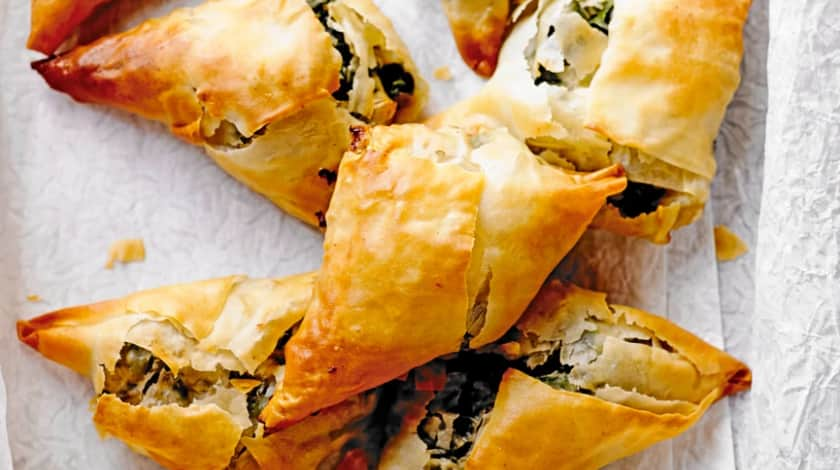Filo pastry, also known as phyllo pastry, is a thin, delicate dough that is layered to create a light and crispy texture. This Mary Berry Filo Pastry Recipe is perfect for making a variety of dishes, from savory appetizers like spanakopita to sweet desserts like baklava. While filo pastry can be challenging to work with due to its delicate nature, this guide will help you master the technique and create perfectly crispy layers every time.
What is Mary Berry Filo Pastry?
Filo pastry is a paper-thin dough used in many Mediterranean and Middle Eastern dishes. Unlike puff pastry or rough puff pastry, filo is not laminated with butter. Instead, multiple sheets are layered with melted butter or oil to create a flaky, crispy texture. Mary Berry’s approach to filo pastry simplifies the process, making it more accessible for home bakers who want to achieve professional results.

Other Popular Recipes
Why You Should Try This Recipe
- Versatile: Perfect for both sweet and savory dishes, from traditional baklava to modern twists like filo cups.
- Light and Crispy: Creates delicate, crispy layers that add a wonderful texture to any dish.
- Impressive Presentation: The paper-thin layers of filo give any dish a sophisticated and elegant appearance.
- Healthy Option: Filo pastry is lower in fat compared to puff pastry, making it a lighter alternative.
- Challenging Yet Rewarding: Mastering filo pastry is a great way to challenge your baking skills and impress your guests.
Ingredients Needed to Make Mary Berry Filo Pastry
- 250g (9 oz) plain flour
- 1/2 tsp salt
- 150ml (5 fl oz) lukewarm water
- 2 tbsp olive oil
- 1 tsp white vinegar or lemon juice
- Cornstarch, for dusting
Equipment
- Large mixing bowl
- Rolling pin
- Pastry brush
- Damp cloth
- Baking tray
- Cling film or plastic wrap
Instructions to Make Mary Berry Filo Pastry
Step 1: Prepare the Dough
In a large mixing bowl, combine the 250g of plain flour and 1/2 teaspoon of salt. Make a well in the center and pour in the 150ml of lukewarm water, 2 tablespoons of olive oil, and 1 teaspoon of white vinegar or lemon juice. Mix the ingredients together until a soft dough forms.
Step 2: Knead the Dough
Turn the dough out onto a lightly floured surface and knead for about 10 minutes, or until the dough is smooth and elastic. The dough should be soft but not sticky. If it’s too sticky, add a little more flour as needed.
Step 3: Rest the Dough
Shape the dough into a ball, wrap it in cling film, or cover it with a damp cloth, and let it rest for at least 30 minutes. This resting period allows the gluten to relax, making the dough easier to roll out into thin sheets.
Step 4: Roll Out the Filo Sheets
After the dough has rested, divide it into smaller portions. Take one portion and cover the rest with a damp cloth to prevent them from drying out. On a surface lightly dusted with cornstarch, roll the dough out as thinly as possible, almost to the point where you can see through it. Use a rolling pin and gently stretch the dough by rolling it outwards from the center.
Step 5: Layer the Filo Sheets
As you roll out each sheet, place it on a lightly floured surface and cover it with a damp cloth to prevent it from drying out. Continue rolling out the remaining dough portions in the same way, layering them as you go.
Step 6: Use or Store the Filo Pastry
Once all the sheets are rolled out, they are ready to use in your recipe. If you’re not using the filo pastry immediately, wrap it tightly in cling film and refrigerate it for up to 2 days. For longer storage, you can freeze the filo pastry for up to 2 months.

What Goes Well With Mary Berry Filo Pastry
Filo pastry is incredibly versatile and pairs well with a variety of fillings and flavors:
- Spanakopita: A classic Greek dish made with spinach, feta, and herbs layered in crispy filo.
- Baklava: A sweet dessert with layers of filo, nuts, and honey syrup.
- Filo Cups: Use filo to make crispy cups filled with savory or sweet fillings like cheese, vegetables, or fruit.
- Apple Strudel: A traditional pastry filled with spiced apples and wrapped in filo.
- Filo Parcels: Small bundles filled with meat, seafood, or vegetables, perfect for appetizers.
- Tiropita: Greek cheese pies made with layers of filo and a rich cheese filling.
Expert Tips for Making the Best Mary Berry Filo Pastry
To ensure your filo pastry turns out perfectly, keep these expert tips in mind:
- Keep the Dough Covered: Filo dough dries out quickly, so always keep it covered with a damp cloth while working.
- Use Cornstarch for Rolling: Cornstarch is finer than flour and helps achieve ultra-thin layers without adding too much weight.
- Roll Evenly: Aim for even thickness across the entire sheet to ensure consistent cooking.
- Layer Generously: When layering filo sheets, brush each sheet with melted butter or oil to ensure they don’t stick together and become crispy during baking.
- Work Quickly: Filo dough is delicate, so work quickly to prevent it from drying out or tearing.
Easy Variations of Mary Berry Filo Pastry
Here are a few ways to customize your filo pastry:
- Whole Wheat Filo: Substitute half of the plain flour with whole wheat flour for a nuttier flavor and added fiber.
- Herb-Infused Filo: Mix finely chopped herbs like dill or parsley into the dough for a flavorful twist.
- Spiced Filo: Add ground spices like cinnamon or cardamom to the dough for a fragrant pastry, ideal for sweet dishes.
- Sweet Filo: Incorporate a tablespoon of sugar into the dough for a slightly sweet pastry, perfect for desserts like baklava.
- Vegan Filo: Use plant-based margarine or oil instead of butter for a vegan-friendly option.
Best Practices to Store Mary Berry Filo Pastry
Proper storage is key to maintaining the delicate texture of filo pastry:
- Refrigerate: Wrap unused filo sheets tightly in cling film and store them in the refrigerator for up to 2 days.
- Freeze: Filo pastry can be frozen for up to 2 months. Wrap the sheets in cling film and place them in a freezer-safe bag. Thaw in the refrigerator before use.
- Keep Covered: Always keep filo sheets covered with a damp cloth while working to prevent them from drying out.
Best Practices to Reheat Mary Berry Filo Pastry
Reheating filo pastry while maintaining its crispness is easy with these steps:
- Oven Reheating: Reheat filo pastry in a preheated oven at 180°C (350°F) for 5-10 minutes. This will help restore the crispness without overcooking.
- Avoid Microwaving: Microwaving can make the filo pastry soggy, so it’s best to avoid this method.
How Can I Make Mary Berry Filo Pastry Healthier?
For a healthier version of filo pastry, consider these adjustments:
- Use Whole Wheat Flour: Replace some of the plain flour with whole wheat flour to increase fiber content.
- Reduce Fat: Use a light brush of oil or low-fat margarine between layers instead of butter to reduce fat content.
- Incorporate Seeds: Add ground flaxseeds or chia seeds to the dough for added nutrition and texture.
Nutrition Value (per serving)
- Calories: 220
- Carbohydrates: 36g
- Protein: 4g
- Fat: 6g
- Sodium: 150mg
FAQs
Can You Make Filo Pastry at Home?
Yes, you can make filo pastry at home, though it requires patience and skill. The key is to roll the dough as thinly as possible, almost to the point of being see-through. Homemade filo is often more flavorful and tender than store-bought, making it worth the extra effort. Using a rolling pin and cornstarch for dusting helps achieve the ultra-thin layers that filo is known for.
How Do You Keep Filo Pastry from Drying Out?
To keep filo pastry from drying out, always cover it with a damp cloth while you work. Filo pastry is very thin and dries out quickly when exposed to air, which can cause it to crack and become difficult to handle. If you’re not using the pastry immediately, wrap it tightly in cling film and store it in the refrigerator to maintain its pliability.
Is Filo Pastry Healthier Than Puff Pastry?
Filo pastry is generally healthier than puff pastry because it is lower in fat and calories. Filo is made with just flour, water, and a small amount of oil, whereas puff pastry contains a higher fat content due to the layers of butter. This makes filo pastry a lighter option for recipes where you still want a crispy, flaky texture without the extra calories.
What Is the Difference Between Filo Pastry and Puff Pastry?
The main difference between filo pastry and puff pastry is in their preparation and texture. Filo pastry is made by rolling out very thin sheets of dough, which are then layered together with butter or oil, creating a light, crisp texture when baked. Puff pastry, on the other hand, involves folding and rolling dough with butter multiple times to create layers that puff up when baked, resulting in a richer, flakier texture.
Final Words
The Mary Berry Filo Pastry Recipe is a wonderful way to create light, crispy layers that add elegance to both sweet and savory dishes. Whether you’re preparing a traditional dish like spanakopita or experimenting with modern filo cups, this recipe provides the foundation for delicious results. With practice, you’ll master the art of filo pastry, impressing your family and friends with your culinary skills.
More By British Baking Recipes
Print
Mary Berry Filo Pastry Recipe
- Prep Time: 40
- Cook Time: 10
- Total Time: 50 minutes
- Yield: 8 1x
- Category: Pastry
- Method: Baking
- Cuisine: Mediterranean
Description
Filo pastry is a paper-thin dough used in many Mediterranean and Middle Eastern dishes. Unlike puff pastry or rough puff pastry, filo is not laminated with butter. Instead, multiple sheets are layered with melted butter or oil to create a flaky, crispy texture. Mary Berry’s approach to filo pastry simplifies the process, making it more accessible for home bakers who want to achieve professional results.
Ingredients
- 250g (9 oz) plain flour
- 1/2 tsp salt
- 150ml (5 fl oz) lukewarm water
- 2 tbsp olive oil
- 1 tsp white vinegar or lemon juice
- Cornstarch, for dusting
Instructions
Step 1: Prepare the Dough
- In a large mixing bowl, combine the 250g of plain flour and 1/2 teaspoon of salt. Make a well in the center and pour in the 150ml of lukewarm water, 2 tablespoons of olive oil, and 1 teaspoon of white vinegar or lemon juice. Mix the ingredients together until a soft dough forms.
Step 2: Knead the Dough
- Turn the dough out onto a lightly floured surface and knead for about 10 minutes, or until the dough is smooth and elastic. The dough should be soft but not sticky. If it’s too sticky, add a little more flour as needed.
Step 3: Rest the Dough
- Shape the dough into a ball, wrap it in cling film or cover it with a damp cloth, and let it rest for at least 30 minutes. This resting period allows the gluten to relax, making the dough easier to roll out into thin sheets.
Step 4: Roll Out the Filo Sheets
- After the dough has rested, divide it into smaller portions. Take one portion and cover the rest with a damp cloth to prevent them from drying out. On a surface lightly dusted with cornstarch, roll the dough out as thinly as possible, almost to the point where you can see through it. Use a rolling pin and gently stretch the dough by rolling it outwards from the center.
Step 5: Layer the Filo Sheets
- As you roll out each sheet, place it on a lightly floured surface and cover it with a damp cloth to prevent it from drying out. Continue rolling out the remaining dough portions in the same way, layering them as you go.
Step 6: Use or Store the Filo Pastry
- Once all the sheets are rolled out, they are ready to use in your recipe. If you’re not using the filo pastry immediately, wrap it tightly in cling film and refrigerate it for up to 2 days. For longer storage, you can freeze the filo pastry for up to 2 months.



